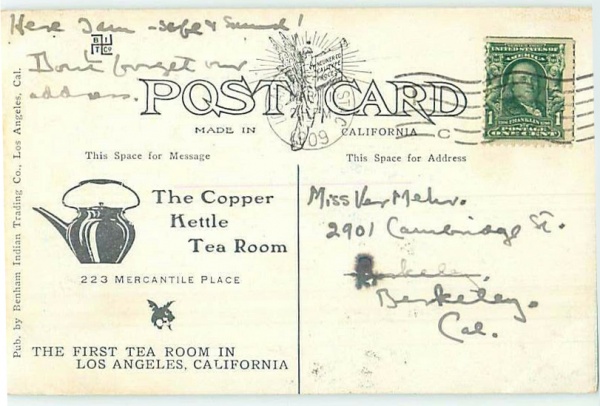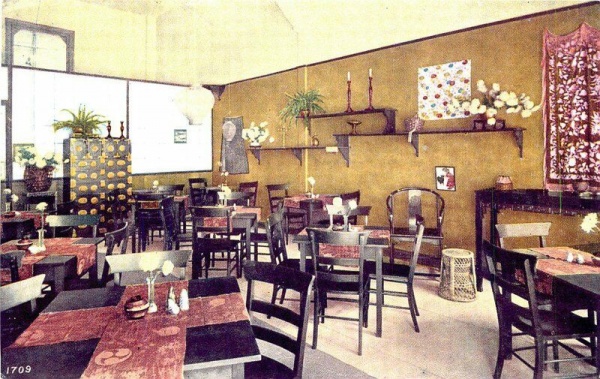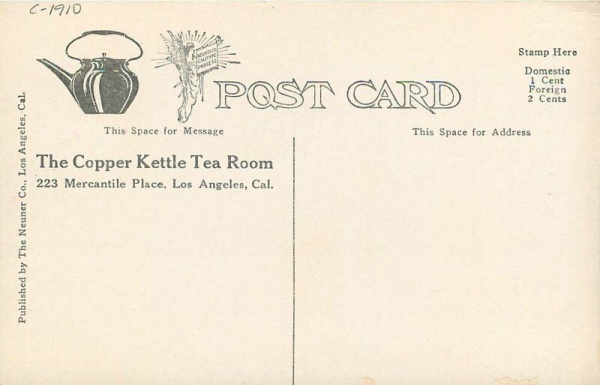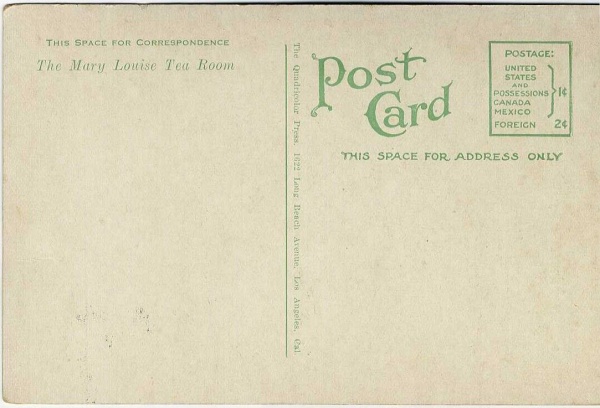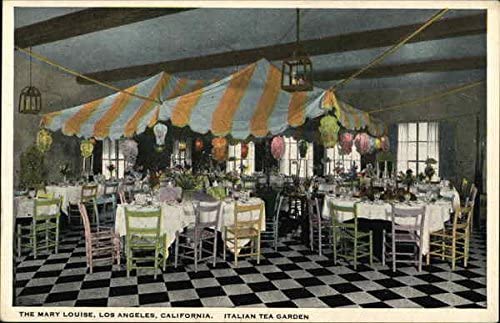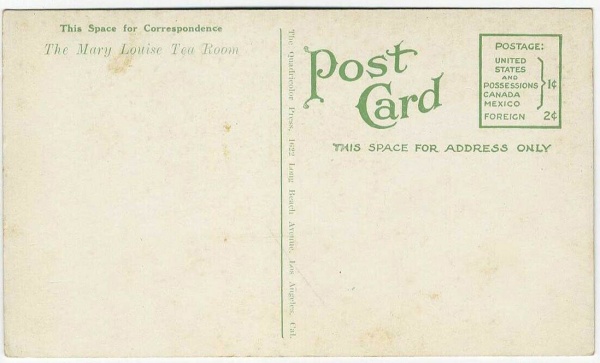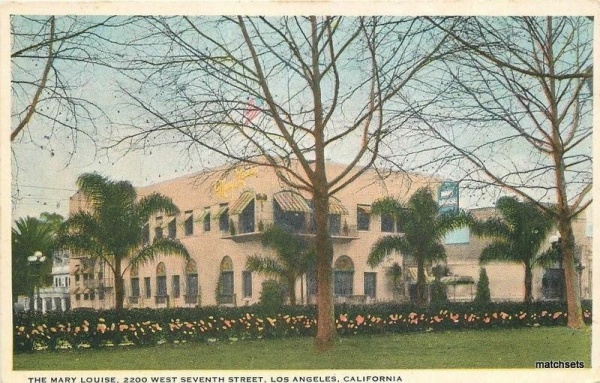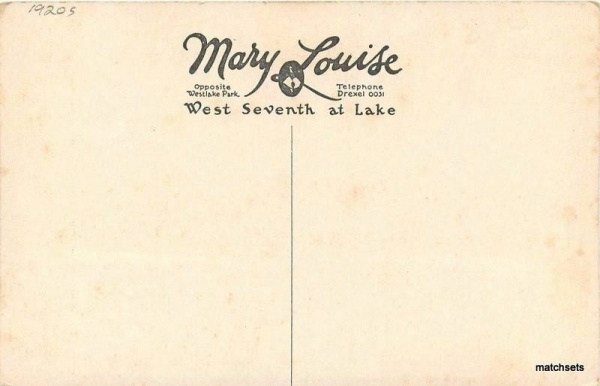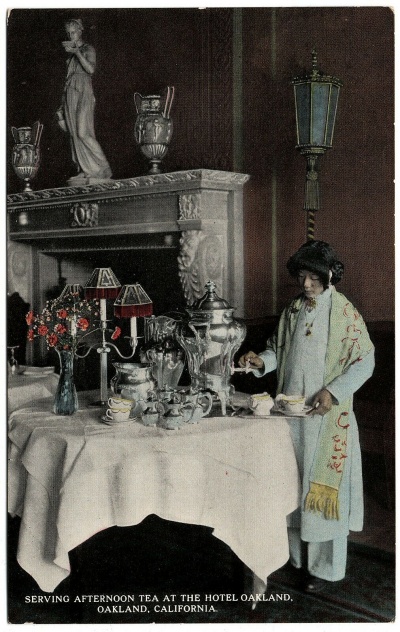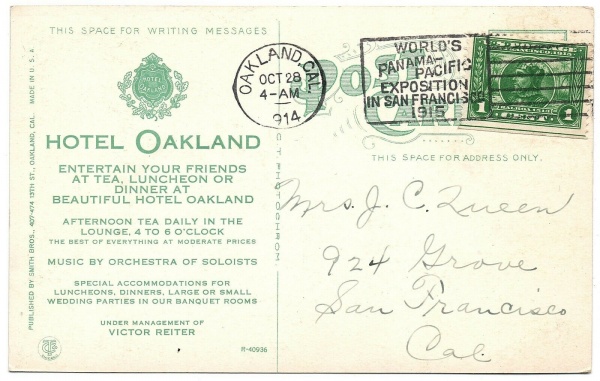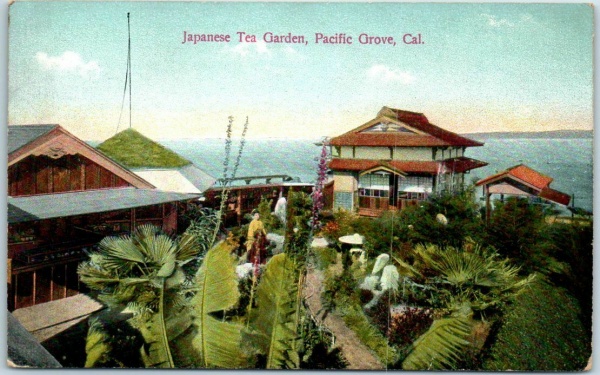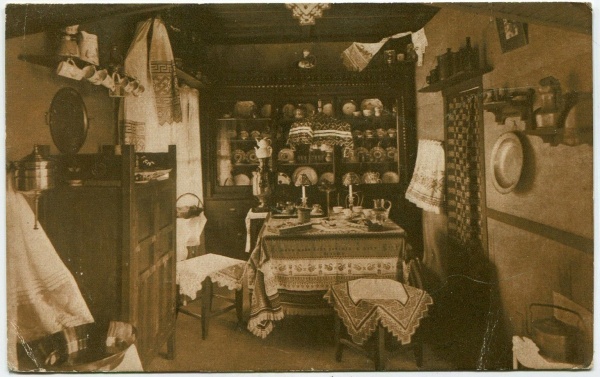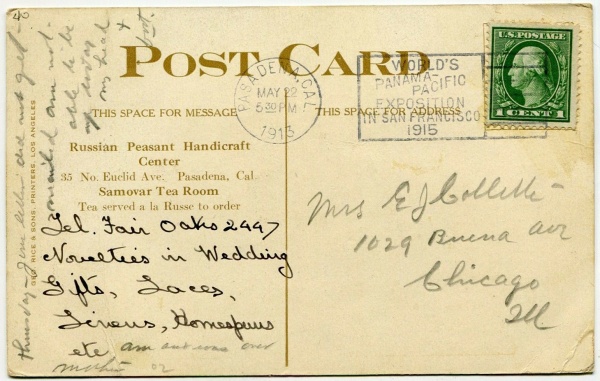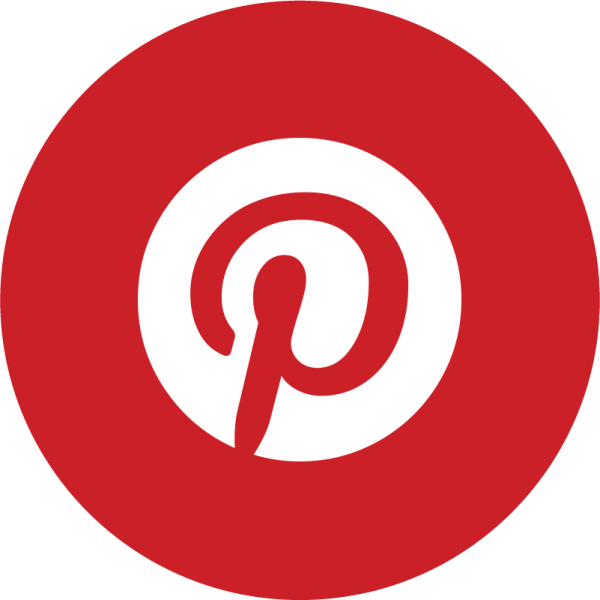California Tea Rooms
From Mystic Tea Room
(Difference between revisions)
(→Buena Park: code improvement) |
(→Buena Park: edit) |
||
| Line 3: | Line 3: | ||
== Buena Park== | == Buena Park== | ||
| - | [[File:Knotts-Berry-Place-Tea-Room-circa-1937-Buena-Park-CA-photo.jpg|center|thumb|600px|Knott's Berry Place Tea Room, Buena Park,California, circa 1937. Although the signage identifies it merely as a "Berry Place," the accompanying menu booklet states that this is a tea room. The Berry Place Tea Room, which opened in 1934, was operated by Cordelia Knott as an adjunct to a large berry farm she co-owned with her husband, Walter Knott. Chicken dinners and boysenberry pies were her stock in trade, and a small gift shop sold her boysenberry jams and preserves. Mrs. Knott's cooking attracted huge crowds, which necessitated enlarging the dining space several times. To keep waiting patrons in a happy frame of mind until tables opened up for them, Walter Knott built a rock garden and waterfall, followed by a western Ghost Town. Eventually, all of the farm land was given over to a popular theme park, Knott's Berry Farm, complete with a narrow-gauge steam train, several roller | + | [[File:Knotts-Berry-Place-Tea-Room-circa-1937-Buena-Park-CA-photo.jpg|center|thumb|600px|Knott's Berry Place Tea Room, Buena Park, California, circa 1937. Although the signage identifies it merely as a "Berry Place," the accompanying menu booklet states that this is a tea room. The Berry Place Tea Room, which opened in 1934, was operated by Cordelia Knott as an adjunct to a large berry farm she co-owned with her husband, Walter Knott. Chicken dinners and boysenberry pies were her stock in trade, and a small gift shop sold her boysenberry jams and preserves. Mrs. Knott's cooking attracted huge crowds, which necessitated enlarging the dining space several times. To keep waiting patrons in a happy frame of mind until tables opened up for them, Walter Knott built a rock garden and waterfall, followed by a western Ghost Town. Eventually, all of the farm land was given over to a popular theme park, Knott's Berry Farm, complete with a narrow-gauge steam train, several roller coaster rides, a theater, and a plethora of costumed characters -- and the berries were grown off-site. Cordelia Knott passed away in 1974 at the age of 84, and Walter died in 1981, just short of his 92nd birthday. In 1997, the Knott family sold the park to a corporation, which runs it to this day. Thus Knott's Berry Place Tea Room may be the single most successful tea room in history. See also the lovely 1937 menu, on our [[Vintage_Tea_Room_Menus#California_Tea_Room_Menus|Vintage Tea Room Menus]] page.]] |
== Los Angeles, CA == | == Los Angeles, CA == | ||
Revision as of 07:30, 9 December 2020
California State Tea Room Gallery, in alphabetical order by name of city or town.
Contents |
Buena Park
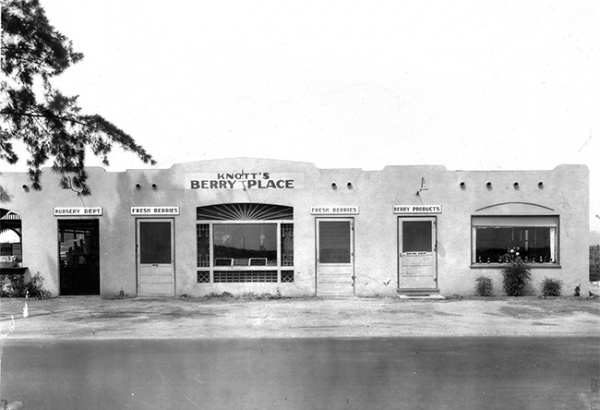
Knott's Berry Place Tea Room, Buena Park, California, circa 1937. Although the signage identifies it merely as a "Berry Place," the accompanying menu booklet states that this is a tea room. The Berry Place Tea Room, which opened in 1934, was operated by Cordelia Knott as an adjunct to a large berry farm she co-owned with her husband, Walter Knott. Chicken dinners and boysenberry pies were her stock in trade, and a small gift shop sold her boysenberry jams and preserves. Mrs. Knott's cooking attracted huge crowds, which necessitated enlarging the dining space several times. To keep waiting patrons in a happy frame of mind until tables opened up for them, Walter Knott built a rock garden and waterfall, followed by a western Ghost Town. Eventually, all of the farm land was given over to a popular theme park, Knott's Berry Farm, complete with a narrow-gauge steam train, several roller coaster rides, a theater, and a plethora of costumed characters -- and the berries were grown off-site. Cordelia Knott passed away in 1974 at the age of 84, and Walter died in 1981, just short of his 92nd birthday. In 1997, the Knott family sold the park to a corporation, which runs it to this day. Thus Knott's Berry Place Tea Room may be the single most successful tea room in history. See also the lovely 1937 menu, on our Vintage Tea Room Menus page.
Los Angeles, CA
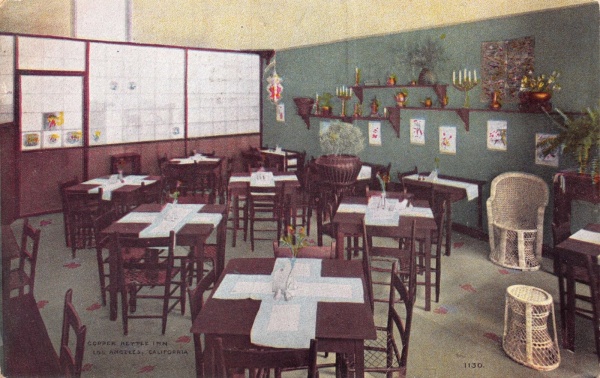
Copper Kettle Tea Room, 23 Mercantile Place, Los Angeles, California, postcard front, circa 1909, published by the Benham Indian Trading Co. The hand-lettered caption on the photo that was the basis for this coloured card reads "Copper Kettle Inn," but that is an error, because all advertising ephemera and references to the establishment in contemporary newspapers and magazines identify it as the Copper Kettle Tea Room. The Copper Kettle opened in 1908 under the proprietorship of two sisters, Smith college alumna Harriet Morris (1880 - 1961) and Barnard College alumna Mildred Morris, helped by their friend Beatrice Wigmore. In addition to tea and light lunches, The Copper Kettle sold Japanese and Chinese basketry and gift wares; by 1915 they were also marketing confections or candies that were sold along the Southern Pacific Railroad route. The building that housed The Copper Kettle -- and, in fact, every shop on both sides of the street, and the entirety of Mercantile Place itself -- was demolished in 1923 as part of a large urban high-rise building program.
]
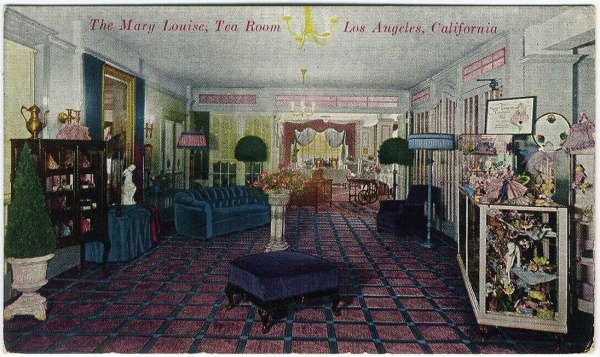
Mary Louise Tea Room Foyer, Los Angeles, California, interior, postcard front. The Mary Louise Tea Room complex occupied a medium-sized building opposite Westlake Park (now MacArthur Park) in Los Angeles. Within its boxy stucco exterior there were rooms furnished according to certain themes. The foyer, which also housed a gift shop, was in lush art deco style. Women frequented the Mary Louise for casual lunches, and they could reserve rooms for club meetings or private parties, and would therefore meet in the foyer. In addition to some statuary, The Mary Louise gift shop carried quite an amazing array of fine porcelain boudoir half-dolls, as can be seen. (To those who are either curious or enthusiastic about porcelain half-dolls, all i can say is that this site is half-doll friendly, and i may write a page on half-doll tea cozies at a later date, but for the true half-doll experience, you should conduct an internet search on your own to find the motherlode of half-doll imagery and the nexi of half-doll collector conversations.) At the far end of the foyer, you can see the formal claret-coloured valances and lace curtains of the main tea room, as well a a rolling tea-cart. White drapery held up over the open entry to the tea room indicates that if it were booked for a large party or reception, it could be closed off to the public.
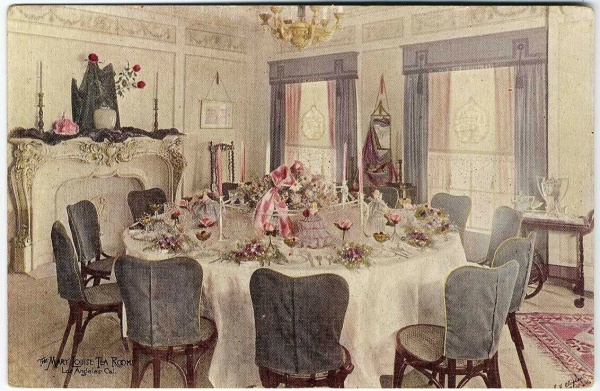
Mary Louise Tea Room, Los Angeles, California, interior, postcard front. This is one of several private side-rooms in the Mary Louise Tea Room complex. It is what we used to call "Fahn-Say" (with a fake French accent) when i was a kid. The decor is Rococo or French Baroque, with a hyper-feminine colour palette of white, pale pink, lavender, and warm grey. Fabric is used extensively to enhance the effect of elegance. Not only is there elaborate drapery, but the backs of the simple cane-bottomed bentwood cafe chairs are outfitted with grey slip-covers in a subtle heart pattern. The large circular table, laid out for a party, is covered in white damask. A central be-ribboned floral mound is set inside of what seems to be netting crafted to represent four tennis nets, stretched between four silver candle stands, each holding a tall pink taper candle. In front of each tennis net is an exquisitely dressed porcelain half-doll, similar to those on display and for sale in the Mary Louise Foyer Gift Shop. There are 12 place-settings, each marked by a single pink rose in a glass bud-vase and a large lavender and white floral corsage for the guests to pin to their dresses, A confection in a sherbet glass, on a gold-rimmed glass under-plate, sits at each place, along with silverware. It may be an ice or a moulded gelatin salad topped with cherries or strawberries. A rolling tea cart at right holds silver tea necessities. A vase of long-stemmed red roses and another finely-dressed half-doll, as well as two candle-stands with white candles, rest on silver lame cloth on the rococo fireplace mantel. The drapery is multi-layered in white lace, pink gauze, and grey silk, with tassels. The gilded electric chandelier (called an electrolier in those days) bears faux white candles. Two framed prints hang from pink tasseled cords, one with an unusually knobbed antique chair beneath it, and the other above a small side table bearing two more silver candlesticks with white candles, a bit of lavender drapery, and an open bowl of ornamental fruits. The Chinese area rug is red, white, pink, and grey, to match the room. This photo is signed, but the copy i have is trimmed in such a way that i cannot say for certain what the signature is. It looks like "J. (or I.) F. Clayton, 2/28/16 (or 26)."
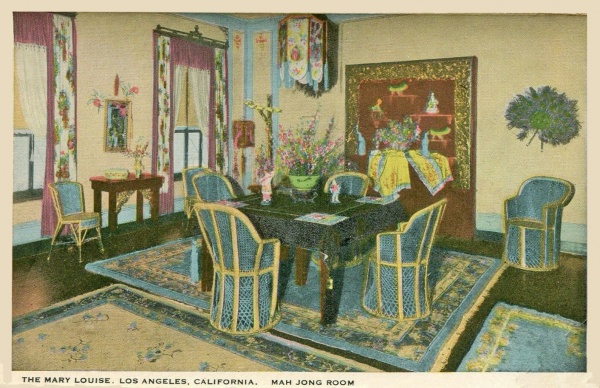
The Mah Jong Room at the Mary Louise Tea Room complex opposite Westlake Park (now MacArthur Park) in Los Angeles, California. This flower-bedecked Chinoisserie room was reserved for parties of women who wanted to play the Chinese game of mah-jong, which was very popular during the 1920s and 1930s. Note the harmonious colour scheme of muted blues and yellows, the gilded curio niche with enshrined Orientalia, the lovely carpets, and the woven rattan furnishings, which are similar to those at the Copper Kettle Tea Room in Los Angeles, California, and at the Sun Parlor Tea Room at the Young Women's Christian Association in Dallas, Texas. Tea came from China, and there were many importers of Asian goods located on the West Coast, so outfitting a tea room as a Chinoisserie was not difficult to accomplish prior to World War Two.
Oakland, CA
Pacific Grove, CA
Pasadena, CA
San Francisco, CA
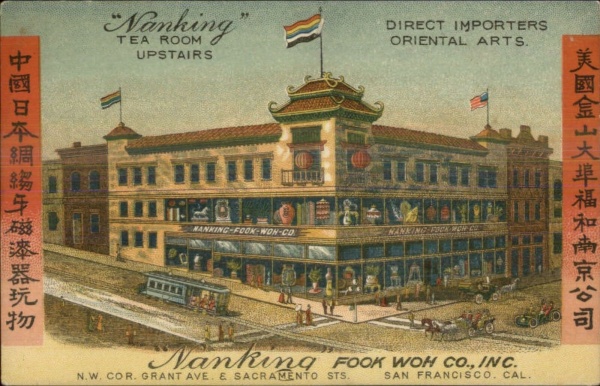
Nanking Tea Room, Fook Woh Co., San Francisco, California, exterior, postcard front. The card dates from 1908 - 1910. It has a divided back, was not postally used, and the vehicles include a street car, an open roadster, and two horse-drawn wagons. Other versions of this card exist, some with no surprinting in the sky area and some with the name Nanking in block letters rather than a script font. The building was erected after the 1906 earthquake and fire. It still exists and now houses a bank.
catherine yronwode
curator, historian, and docent
The Mystic Tea Room
